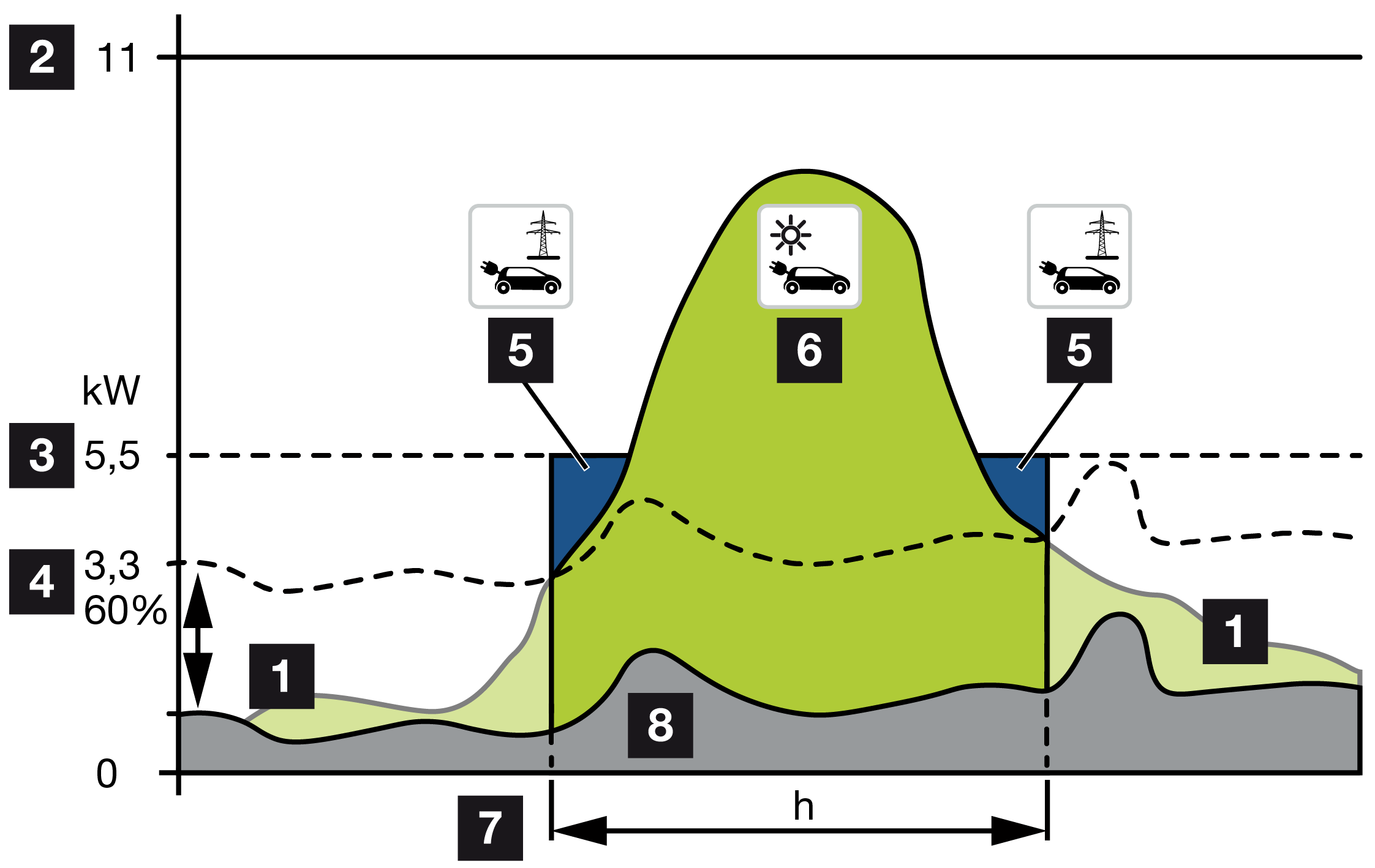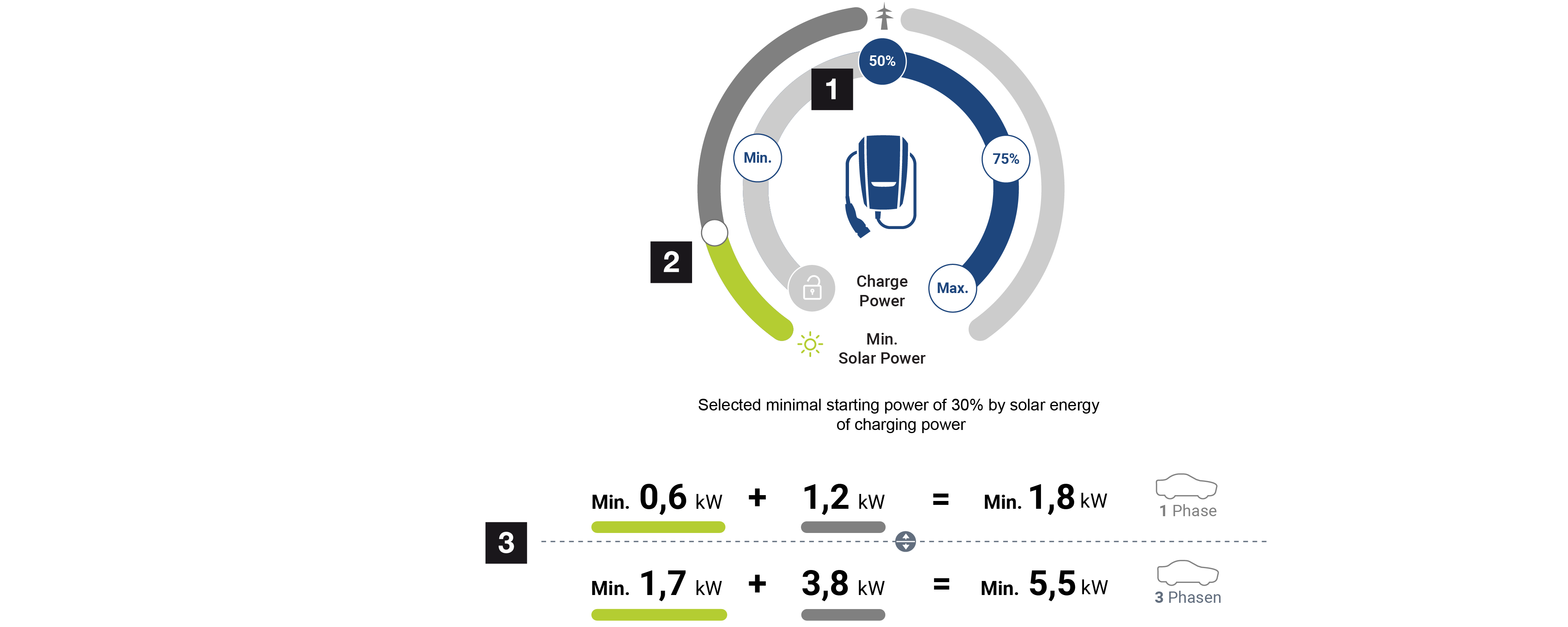Solar Plus Mode (solar-optimised charging)
Solar-optimised charging is only possible in combination with a PV system and the KOSTAL Smart Energy Meter. The PV system supplies the energy needed to charge the electric vehicle.
If there is a PV surplus at the grid interconnection point, the amount drawn from the grid is replaced by the PV power or, if possible, increased to the PV surplus.
If desired, a minimum PV surplus power can also be defined here. This is the minimum level which must be present before charging is started at the power level defined by the customer. If the surplus power falls below the defined minimum value, charging is stopped again.
This function can be used to charge the electric vehicle in the evening, for example, when there is no longer enough PV energy available but the electric vehicle needs to be charged for the next morning.

1 | PV surplus This surplus can also be used to charge a battery. |
2 | Max. wallbox charging power 11 kW (3-phase). |
3 | Fixed minimum starting charging power. In this example, at 50% of the max. charging power of 11kW (for 3-phase connection with 3-phase vehicle = 5.5kW). |
4 | Set min. surplus power at the grid connection point before charging is started. In this example, 60 % of 5.5 kW = 3.3 kW. The additional charging power of 2.2 kW (5) is drawn from the public grid. |
5 | Charging electric vehicle from the public grid. In this example 2.2 kW. |
6 | Charging electric vehicle from PV surplus. |
7 | Electric vehicle charging time. |
8 | Home consumption of other devices - partly covered directly from PV. |
Setting the start charging power

1 | Set the target start charging power. |
2 | Slider for setting the ratio between solar power used and the amount drawn from the grid in Solar Plus Mode. |
3 | Presentation of charging values for electric vehicles. |
Target start setting
Min. | The minimum charging power of the connected electric vehicle is determined and set (1-phase 1.4 kW / 3-phase 4.1 kW). |
50 % | The charging power is set to 50 % of the maximum charging power of the electric vehicle (1-phase 1.85 kW / 3-phase 5.5 kW). |
75 % | The charging power is set to 75 % of the maximum charging power of the electric vehicle (1-phase 2.8 kW / 3-phase 8.25 kW). |
Max. | The maximum charging power of the connected electric vehicle is determined and set (1-phase 3.7 kW / 3-phase 11 kW). |
INFO

Clouds/hysteresis for drawing power
If the necessary excess power is not available, charging is maintained for approx. 5 minutes at the minimum charging power to avoid unnecessary switching on and off. After the hysteresis time has elapsed, charging is interrupted and only resumed after a wait time of approx. 8 minutes.
Setting the desired minimum share of solar power
In Solar Plus Mode, the slider can be used to set the ratio between the solar power used and the amount drawn from the grid.
Lock Mode | Wallbox locked. The slider has no function. |
Power Mode | Full charging power from all available sources. The slider has no function. |
Solar Pure Mode | 100 % of the energy is drawn from the PV system for charging. The slider has no function. |
Solar Plus Mode | Set the ratio between solar power and energy drawn from the public grid. Example: If 30 % solar power / 70 % drawn from grid is set, there must be at least 30 % solar power before the charging process is started. The remaining energy is drawn from the grid. If the solar proportion increases, the amount drawn from the grid is reduced. |
Display of charging values for 1-phase and 3-phase electric vehicles
The illustration at the bottom shows the setting in kW for 1-phase or 3-phase vehicles. If more solar power is generated than the min. set, the amount drawn from the grid is reduced by the corresponding proportion.
Prioritisation of charging power with connected battery storage (PLENTICORE plus/PLENTICORE BI)
If a KOSTAL battery system with the PLENTICORE plus or PLENTICORE BI components is installed in the system, this inverter must be set up via the IP address in the KOSTAL Smart Energy Meter (via Inverter > Devices).
In this case, priority is given to supplying the wallbox with surplus power for the solar modes. The battery storage unit is only charged when the electric vehicle is no longer drawing power.
INFO

When using external storage systems, PIKO BA systems, PIKO MP plus with KOSTAL Smart Energy Meter and battery, fault-free use of the solar modes cannot be guaranteed as different control systems will be controlling the surplus and interfering with each other's control.